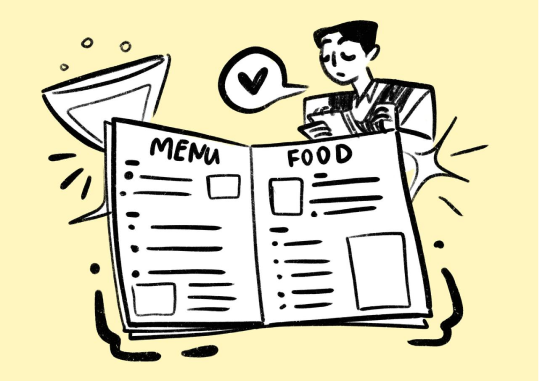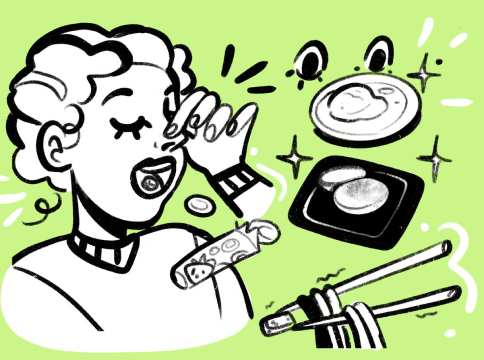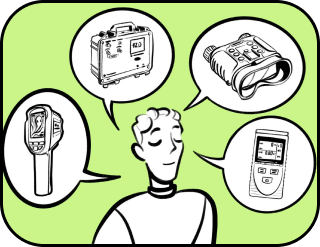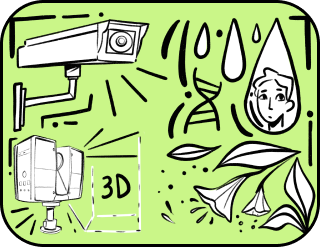How the brain turns food into pleasure: The science of neurogastronomy
Programmed for pleasure:
We live in a world where there are more addictions than can be counted. Who would have thought that food would become one of those strings that pull us, like puppets, in their interests. Our eager fingers reach for the forbidden fruit, almost as if guided by an intrinsic beacon of desires. And it begs the question: does this bear a resemblance to the art of NLP programming?
Imagine the rush of dopamine we feel when we see, smell, or taste fatty or sweet food. This invisible chemical signal makes us desire more, and before we know it, we’re ready to eat up to the dump. Delicious food isn’t just a delight — it’s a wellspring of ecstasy. Like any other way to experience pleasure, it triggers a series of chemical reactions and biological processes that drive us to experience gastronomic bliss again and again.
It turns out that food is almost like a magical cocktail of happiness hormones that we can afford at any time, and we want this cocktail again and again.
But if there is a great variety of available products, how do we choose a particular restaurant, cuisine or dish to eat from this multitude? Why do we want a piece of cake, but after a while we find ourselves devouring slices of palm with five different fillings of vanilla pudding or truffle puree and rye bread?
Restaurateurs are the enchanters of manipulation, weaving spells that compel us to consume anything, extracting the maximum amount of money from us, and getting us hooked on their establishments. How do they manage to do this? Traditionally, we have both a life and technological responses.
In the world of restaurants and cafes, there are real wizards who have the power to solve marketing challenges by transforming menus into tools for manipulating our minds through the art of programming.
It sounds like the opening scene of a low-budget horror movie, doesn’t it?
First of all, customers are hypnotised through the menu. It’s like a first date, where the first impression plays a crucial role. That’s why the most lucrative dishes are strategically placed at the start of the menu: what catches your eye first is what sticks in your memory the strongest.
For instance: “Sloe salad with volcano ash and rare orchid pollen” — doesn’t that just make your mouth water? And now you’re already reaching for your credit card. But when you spot the first menu item labeled “Delicacy of the Day,” remember, it’s not just a “top pick,” but a clever ploy. And how could you resist the “overpriced lobster in tapenade sauce,” gleaming like the sun itself!
Then comes the power of anchoring. Yes, that NLP technique. You’re welcomed by an enthusiastic hostess: “Good day! How are you today?” and immediately handed a glass of green elixir labeled: “Elixir of Longevity.” Trust me, every time you see that glass, you’ll instantly think of this restaurant and feel a strong urge to prioritise your health.
While you’re finishing your trendy and healthy greens, the waiter is already rushing to you: “Thank you for choosing our restaurant! Now you’re one step closer to your perfect body!” In that moment, you feel like a hero, deserving of admiration, and that feeling compels you to return for more.
“I don’t want to choose — just give me something ready-made.” This is the paradox of choice. Choosing between 50 types of pasta? No, thank you!
Restaurateurs are well aware that guests experience a slight stress while navigating the menu’s labyrinths, almost as if they are choosing their destination for a lifetime vacation. That’s why a clever tactic often appears in menus: reducing the number of options to manageable sizes. Now, amidst the abundance, you’re faced with a choice between “classic spaghetti” and “lobster spaghetti.” Which one is easier to choose? The cheaper one, of course!
“Don’t think about money, just enjoy.” Can’t find the prices on the menu? That’s because it makes ordering easier. By removing the cost, restaurants aim to shift your focus from price concerns to the pure enjoyment of flavours and experiences.
A $100 steak? An exorbitantly priced piece of meat on the menu is not just a culinary masterpiece, it’s a fishing lure: it grabs your attention, making everything else seem budget-friendly. The guest’s brain reasons: “If I’m going to spend money, I might as well not overpay.” So, thinking you’re being rational, you opt for the $30 steak instead of the extravagant delicacy. And the restaurant is perfectly content with that choice.
“Our tender chicken breasts in sauce with Hollandaise Béarnaise, like a mother’s warm embrace.” The captivating descriptions elevate dishes to irresistible levels, turning a simple “chicken fillet” into a culinary adventure. Hearing that the Italian pasta was “handmade by the chef himself” you’re willing to spend more because it sounds like something you simply must try!
This is how, using NLP techniques and marketing tricks, one can turn any person into a loyal customer of a restaurant serving not-so-healthy food and less nutritious meals.
Can we program ourselves to desire specific foods? Easily. Just visualise the food, picturing each morsel melting in your mouth, igniting waves of delight. You can shape your inner dialogue with positive affirmations about the taste and texture of the dish. Using the power of your mind, you can command yourself to derive maximum pleasure from any food. Remember the mantra from the movie? “I’m one with the chicken. I’m one with the chicken.”
NLP truly provides tools to enhance gastronomic experiences and derive maximum pleasure from them.
The only one troubling nuance is that in today’s world, neuro-linguistic programming can make choices for us. It starts with food, extends to other purchases, and who knows where it leads next…

Who truly selects our food: the taste buds, the stomach, or perhaps the brain?
It turns out that there is a whole science that can provide an answer to this question — neurogastronomy.
There is absolutely no taste in food, just like there is no colour in a rainbow. Taste and colour are qualities that our brain attributes to the objects surrounding it. From this, it can be concluded that taste perception can be influenced. And NLP has nothing to do with it.
Our individual perception of smells and how they alter the taste of food depends on our unique set of receptors: certain dishes may trigger an overwhelming desire, while others may elicit a strong aversion. It’s almost as if each of us possesses our own “scented fingerprint.”
We sink our teeth into a juicy piece of meat, and our taste buds explode with ecstasy. But when we taste a canned carambola, our brain cringes as if we’ve swallowed a whole jug of grandpa’s cologne.
Chips and fried potatoes are true drugs for our brain. And according to brave tasters, snake tastes like a strange mix of pork ribs, frog legs, and soil.
And what about this aromatic bun? Is it really as fragrant as it seems?
Our cunning brain simply deceives us, creating the illusion that the scent originates in the oral cavity rather than the nose. It appears that we are wrong in assessing food with a simple “like-dislike” approach; perhaps “sense-don’t sense” would be a more fitting evaluation.
Taste is more than a chemical reaction; it’s a rich sensory experience where memory, emotions, sight, smell, and even sound all come together. Our tongue is a true mini laboratory where unique chemical reactions take place.
Not everyone realizes that our tongue vibrates at a frequency of 50 Hertz thanks to Sichuan pepper, and our stomach, like a demanding addict, clamors for more refined flavours. And after indulging in them, it savors the classical music of the legendary composers.
The majority of what we perceive as taste is actually due to our sense of smell. The taste receptors in our mouth can only detect basic flavours like sweet, sour, salty, bitter, and umami. The richness of food flavours comes from our nasal receptors. The connection between our nasal and oral cavities allows food odors to reach our nose, creating a blend of taste and aroma that we experience as the “flavour” of the food. By holding our nose, we block the scents from reaching our olfactory receptors, leaving us alone with just the five basic tastes.
Would you like to try it out? Pinch your nose and put a fruity candy into your mouth. Chances are, you’ll only taste the sweetness and may struggle to identify the specific fruit flavour.
The experience of taste is not solely dependent on the tongue but also involves other sensory organs. Scientists are delving into how factors like plate shape, colour, music, and even sounds impact our perception of a dish.
A waffle served on an elegant black plate is perceived as exceptionally delicious and evokes a strong desire to indulge in it, despite being no different in ingredients or preparation from a waffle on a regular plate.
Placing ice cream on a white round plate makes its taste appear 10% sweeter and 15% richer compared to the same dessert served on a black square plate.
Eating food off a knife may seem a bit saltier than the same food on a fork or culinary skewer.
Scientists have proven that we perceive food based on sound as well. A significant component of the taste of crunchy foods (such as chips, cucumbers, or carrots) is their crunch. When people are given the opportunity to try these foods with headphones on, their ratings of freshness and taste significantly decrease.
Background noise alters the taste of food: it makes it less salty and sweet. To some extent, this explains why food on airplanes is sadly known for its rubbery tastelessness — the engines and ventilation work too loudly.
Heavy rock music interferes with distinguishing taste qualities. Any dish will seem more bland in such a context than in a quiet environment. The thematic musical accompaniment plays a significant role in enhancing the culinary masterpiece. For example, seafood served on transparent dishes with the sounds of waves and seagulls’ cries allows the guest to truly enjoy the experience.
Chef Heston Blumenthal is already experimenting with “multisensory” dishes that aim to make us hear, see, and feel food in new ways. Picture yourself savouring the “Sounds of the Sea” with the roaring waves in the background or indulging in “The Last Supper of Pompeii” as you embark on a journey through time!
And what about wine, a true multi-sensory symphony? French chef Paul Bocuse once wrote that the perfect wine ‘satisfies all five senses beautifully: its colour — sight, bouquet of aromas — smell, coolness — touch, flavours — taste, and the sound of pouring from the bottle “glug-glug” — hearing.’ It’s a complete sensory concert for our senses!
First, we “drink” wine with our eyes, marveling at the rich purple hue in the glass — this cephalic phase where our brain anticipates pleasure. Then we taste this divine elixir, and the other senses come into play. Cool lips feel the silky texture, the tongue discerns the subtle flavour nuances, and the retro-nasal olfaction detects the aromatic molecules. Each sense paints its own picture of the wine, and the brain combines them into one incredible tasting experience.
Yet the symphony continues to play on. The orchestrated movements of our jaw, cheeks, and tongue awaken the corresponding neurons in our brain. The hippocampus, the “hard drive” of our mind, records this unforgettable encounter, while our emotional centers overflow with a sense of pure joy and happiness. Even the language zones of our brain strive to articulate this flavour: is it fruity? Tangy? With subtle notes of cherry?
As you take a sip of wine, it causes a real stir in your brain — representations of all sensory organs, analysis and processing areas, motor cortex, memory systems, emotional and motivational systems, and even the most “human” part of the brain — the prefrontal cortex — become activated.
Neurobiologist Gordon Shepherd suggests that taste recognition is one of the most complex processes occurring in the darkness of our skulls. Apparently, life without delicious sensations would be too dull for us.
Once in Oxford, experimenter Charles Spence discovered that stroking sandpaper on a smooth surface influences the perception of the taste of ginger cookies, coffee, or wine! It is suggested that by feeling the unusual texture, people start to perceive the taste more acutely.
But that’s not all!
Stepping into the spotlight is the food-sweetening spoon. Drawing inspiration from their Japanese counterparts, in 2022, scientists from Japan unveiled electric chopsticks that infuse food with a salty flavour! As one wields these chopsticks, a gentle electric current interacts with sodium ions in the food, transforming even mildly salted dishes into delectable treats that rival their fully salted counterparts.
In the future, people will be able to enjoy sweet and salty foods without harming their health, simply by using special tableware! There will no longer be a need to rely on sugar substitutes or restrict salt intake; instead, individuals can adjust the taste using smart gadgets.
Neurogastronomy is not just a pastime for gourmets, nor is it merely a way to manipulate consumer preferences without their conscious choice. This groundbreaking science holds the power to aid individuals who have lost the joy of taste and scent, or guide people towards healthier dietary choices. Perhaps it will even foster a preference for eco-friendly products among people, making our favourite dishes not only enjoyable but also the most sustainable for the planet!
Perhaps we’ve had our fill of technology for today.
Time to grab a snack!

According to the Big Bang Theory, the Great Explosion of discoveries starts right now.
Thank you!




